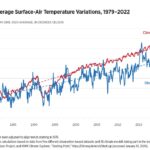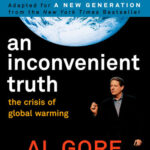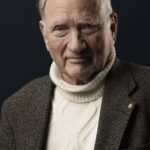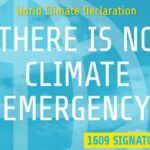Global warming: Interview with John Christy–Models, sensitivity, the PNAS paper and more
Environmental Policy Examiner Thomas Fuller
John Christy is an atmospheric scientist and Professor of same at the University of Alabama in Huntsville, and winner of achievement awards from NASA and the American Meteorological Society. He was a lead author of the IPCC’s 2001 Assessment Report, but in 2007 was quoted in the Wall Street Journal as saying, “I’m sure the majority (but not all) of my IPCC colleagues cringe when I say this, but I see neither the developing catastrophe nor the smoking gun proving that human activity is to blame for most of the warming we see.”
The awards he received were for his work in helping develop a temperature dataset based on satellite measurements, and one of the major datasets used in climate science is just known as UAH. He is commonly perceived as a skeptic, but as has been the case with every interview I’ve done in this sector, the truth is far more nuanced. Professor Christy was kind enough to respond to my request for an interview very quickly, so without further ado…
Examiner: You are commonly labeled as a ‘skeptical’ scientist who does not agree with the IPCC consensus regarding human contributions to climate change. How accurate is that, and how would you describe your own beliefs regarding this.
J.C. I am mainly skeptical about those who claim to be so confident in understanding the climate system that they know what it is going to do in the next 100 years. This is my main complaint – overconfidence. We of all professions should be the most humble because there is so much about the climate system that we simply do not know. See my testimony given to the Inter Academy Council in June concerning these ideas – I think you will appreciate it.
(In his June testimony to the Inter Academy Council, Christy testifed that he felt the IPCC’s overconfidence in climate models was not justified. He also said: “The first objection I raised regarding the Third Assessment was that the fabled Hockey Stick was oversold as an indicator of past climate change. This was well before the critical work of the Wegman Report, National Academy of Sciences, McIntyre’s papers and the East Anglia emails. Indeed, I urge you in the strongest terms to engage Stephen McIntyre in your deliberations at a high level as he has accurately documented specific failures in the IPCC process, some of which I can attest to, as I was there.”)
Examiner: What unresolved issue or issues should the scientific community be focussing its gaze on with regards to climate change in 2010? Atmospheric sensitivity to a doubling of CO2?
J.C. Evidence is building that the sensitivity is less than models assume.
Examiner: The role of the oceans in exchange of CO2 and heat?
J.C. This relates to sensitivity.
Examiner: The role of the clouds?
J.C. This is directly related to sensitivity, i.e. how do the reflective clouds respond to an impulse of warming – evidence indicates they expand (reflecting more sunlight) and counteract the warming. This has also been shown for cooling events, i.e. that clouds contract when a global cool spell occurs to let in more sun and warm the planet.
Examiner: The accuracy of the historical records?
J.C. This is an ongoing effort – to build an archive of raw observations in which all parties have confidence.
Examiner: What are you personally focussing on in your work?
J.C. Measurements of all types. I just recently had a paper on snowfall in the southern Sierra published showing no trend in the last 94 years which indicates natural water resources in the San Joaquin Valley are fine, so that shortages are clearly a function of management and law (see attached). I am still building temperature datasets of the surface and upper air to document the response (temperature is a good response variable to forcing) of the atmosphere to forcings of all types.
Examiner: What are your beliefs about what is happening to the Earth’s climate?
J.C. Natural variability is still the major driver of the climate changes that create challenges for society. The one confident conclusion we can make about added CO2 is that the biosphere has clearly been invigorated – plants love what we do with carbon-based energy because its by-product is CO2 – plant food. (I can hear the shrieks of horror all the way here in Alabama from California, my home state.)
Examiner: What do you think governments and their citizens should be doing to protect our environment and our future?
J.C. In my experience, the wealthier the country is, the better is its environment (mainly because energy in wealthy societies is produced in high density processes like power plants rather than gathering of wood and biomass which destroys habitats.) Policies that allow human wealth and security to be enhanced are policies that can sell. The wealthier a society is, the greater emphasis it can put on protecting natural habitats, cleaning the air and water, and protecting its citizens from threats of all kinds (i.e. disease, weather disasters, etc.) This wealth building occurs best in democratically accountable societies which establish human rights for all citizens, including women and children.
Examiner: Paul Krugman recently took up a current argument that in the face of uncertainty our actions should be more vigorous, not less. How would you respond to this?
J.C. Will these actions advocated by Krugman cause economic decline, lower standard of living, etc? If so, they don’t have a chance in a democratically accountable society. I think we are creating more certainty about the idea that the climate is less sensitive to CO2 than promoted in the past 2 decades. We are not all going to die on a roasting planet. The real challenge today is to prepare for the unquestionable continued rise in energy demand. Energy makes life much, much better in countless ways, so it’s demand will only increase, especially in poorer countries. At some point, even carbon-based energy won’t meet the demand, so new and voluminous sources of energy are needed … and the sooner the better.
Examiner: Stephen Schneider recently co-authored a paper published in PNAS exploring the level of expertise found in scientists who support the consensus position on climate change compared to those who do not agree with the consensus. What is your reaction to this paper?
J.C. I was one of only three scientists who made both the “good guy” and the “bad guy” lists. Quite an honor I suppose. However, I think the study was pathetic. It basically says, “Those of us who agree with each other like to cite the work of our friends and not the other guys.” Duh. (One of my fellow scientists calls this “tribalism” – an appropriately primitive description.) I think the more sinister motive was evident in that the paper chided the media, such at the SF Chronicle, to stop investigative-reporting and just “trust us” (the guys on the “good guys” list) when it comes to climate change. It really was an attempt to make a blacklist. In that sense, I guess I ended up being gray, which fits my hair color now.
Examiner: The IPCC accepts the submission of general circulation models from all participating countries. I think there are 23 or 24 of them right now. Is that a useful number of models to analyze?
J.C. What you want is a set of models that at least represent the real atmosphere (which none of these do faithfully relative to tests we’ve performed.) This does seem like a high (and expensive) number.
Examiner: Does an average derived from an ensemble of models tell us anything useful? If so, what? If not, what are the defects of looking at an ensemble of models.
J.C. Probably not. Cloud processes and responses are particularly off the mark (or at least widely varying). The question here addresses a fault with consensus – over time, individuals tend to drift toward consensus (a human foible) whether it is right or wrong. Many of the parameterizations in the models are very similar and could be very wrong, so agreement with each other is often a dangerous result as it confirms one’s prejudices and gives one a false sense of success. I deal in the world of observations – i.e. what does the real world show. What we find is that models have a long way to go, which is a little ironic because they modelers have a legitimate reason to clamor for more funding to improve their poorly-performing models.
Examiner: Human emissions of CO2 declined 2.6% in 2009, although concentrations didn’t change. How hopeful are you that our actions can reduce emissions further?
J.C. It is very clear that economic decline means less energy is used, and people are poorer as a result. So, one should congratulate those who created the recent economic collapse for the “good” news on emissions. However, I don’t see economic decline as a long-term strategy for society to follow. The most useful option to slow the decline in emissions is to proceed on a massive construction initiative in nuclear power (which has other defensible reasons to back it up – not just alleged climate change.) In this way, gigawatts of power can be produced with little emissions. Alternatives (wind, solar, animal methane) will be just an expensive and unreliable blip on the world-wide scale of emissions growth.
Examiner: What is your best guess or opinion on what will happen to the Earth’s climate over the coming decades?
J.C. The climate will throw some surprises at us and the interannual variations that we’ve always had will continue to cause the greatest developmental challenges. As I said 22 years ago my general rule of climate is: “If it happened before, it will happen again … and probably worse.” Are we prepared for the variations we have already experienced (i.e. 1930’s, 1950’s droughts, 1993 floods, any hurricane, freeze of 2007, snow of 2009-10, etc.?”). If we are prepared for those, anything induced by humans on top of the climate system’s large natural variability will be manageable in my view.
Note to readers: I may go back to Professor Christy with a second round of questions. If you have your own, leave them in the comments.
Bron: examiner.com






A must read!
Amadeus is looking forward to the second interview!